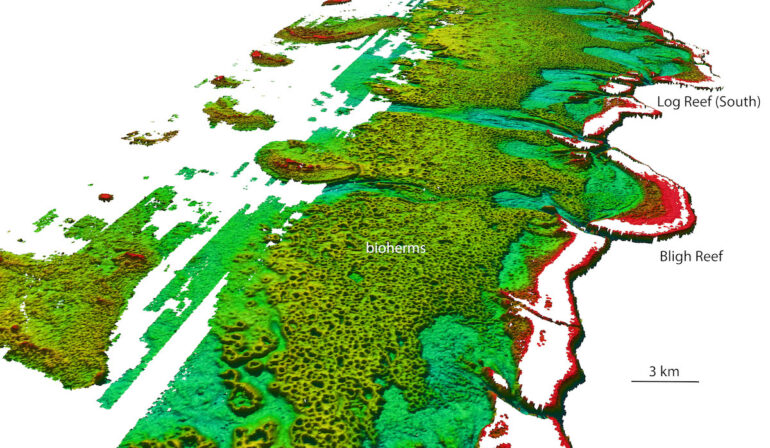Scientists from James Cook University, University of Sydney and Queensland University of Technology have just discovered a vast Halimeda reef hiding in plain sight.
Halimeda is a green macroalgae composed of calcified leaf-like segments. As these segments die, they accumulate over millennia as thick mounds called bioherms. The newly discovered Halimeda reef consists of a living layer of Halimeda algae, which covers the bioherms, and the reef covers an area of 6095 km2, on the landward side of the northern Great Barrier Reef.
Although the Halimeda habitat was previously known to GBR scientists, this new study shows the reefs are three times larger and more complex than previously thought.
Scientists used high-resolution airborne LiDAR and multibeam bathymetry datasets to gain a more accurate calculation of the bioherms. Previous studies of the reef used sediment grabs, coring and seismic profiling, and the distribution was estimated at 2000 km2 using interpolation from echosounder profiles.

Seminal literature describes the Halemida habitat as ridges and troughs running parallel to the reef. While these new findings show the reef as having a complex reticulate morphology with three distinct morphological sub-types: reticulate, annulate, and undulate.
Conservation
The vast expanse of living Halimeda on top of the bioherms, and the structural complexity of the bioherms themselves, create a significant inter-reef habitat.
Although not much is known about their exact role in the GBR ecosystem, their value regarding biodiversity, nursery refugia, and role in larval dispersal and patch reef connectivity may be comparable to that of seagrass meadows and mangrove habitats.

Mardi McNeil from Queensland University of Technology and lead author on the new research paper, said the extent of Halimeda bioherms is vast.
“We’ve now mapped over 6000 square kilometers. That’s three times the previously estimated size, spanning from the Torres Strait to just north of Port Douglas. They clearly form a significant inter-reef habitat which covers an area greater than the adjacent coral reefs.” [James Cook University]



